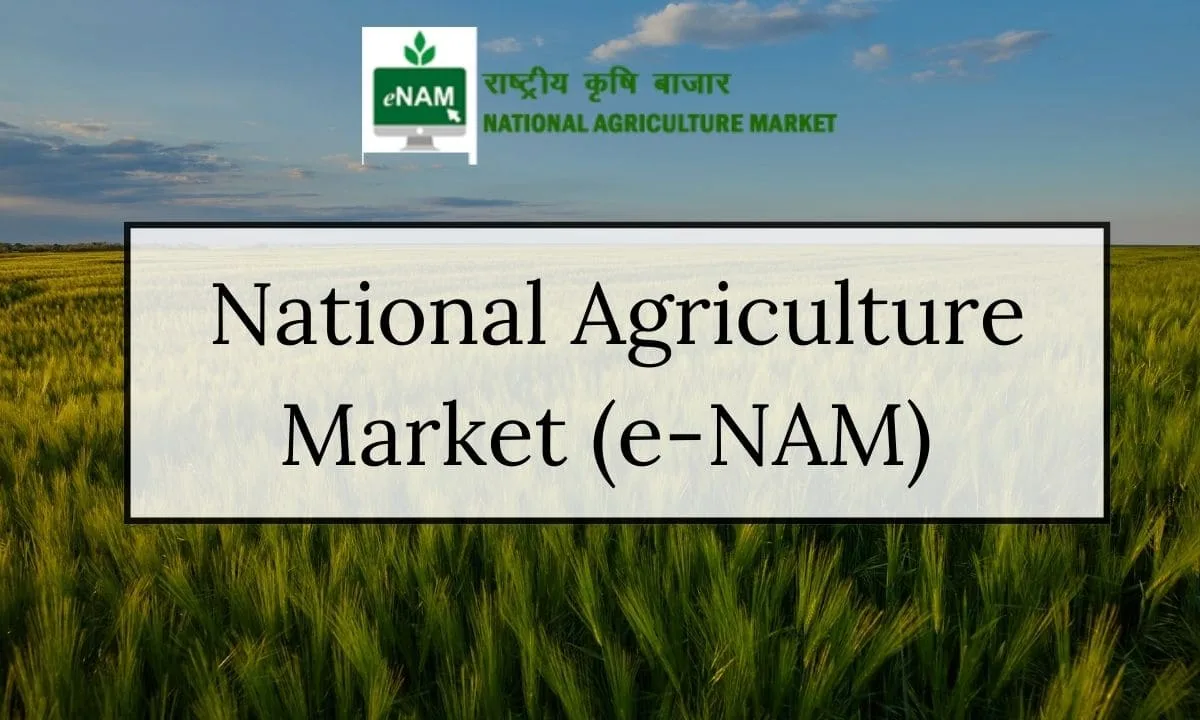For many years, Indian farmers urgently required a direct marketplace to sell their produce. Many farmers used to face challenges due to intermediaries or middlemen and a lack of a transparent, accessible platform. A dedicated marketplace would empower farmers by providing them with the opportunity to reach consumers directly, cutting down on middlemen and ensuring fair prices for their agricultural goods. Such a platform would not only enhance their income but also offer a streamlined and efficient channel to showcase and sell their products. Acknowledging this, the Government of India launched the National Agricultural Market or e Nam, a direct marketplace to sell produce in India.
In this article, we are going to talk about the National Agriculture Market, commonly referred to as eNAM in detail. In case of a query regarding the scheme, you can comment on your doubt or mail us.
What is eNAM?
The National Agriculture Market, commonly referred to as eNAM, stands as a prominent initiative by the Government of India aimed at establishing a consolidated national marketplace for agricultural commodities. This scheme is fully financed by the central government and operates under the jurisdiction of the Ministry of Agriculture and Farmers’ Welfare. The inauguration of eNAM took place on April 14, 2016, with the honorable Prime Minister, Narendra Modi, leading the launch.

The e-NAM portal offers a unified platform for all APMC-related information and services. This encompasses details on commodity arrivals, quality assessments, pricing, buy and sell offers, and direct e-payment settlements into farmers’ accounts. Its objective is to foster consistency in agricultural marketing by simplifying procedures throughout the integrated markets. By eliminating information gaps between buyers and sellers, the platform facilitates real-time price discovery based on actual demand and supply. The overarching goal is to create a more transparent and efficient marketplace, providing a single window for diverse agricultural activities and enhancing the overall experience for both producers and buyers.
| eNam Portal 2023 Key Highlights | |
| eNam Portal Launch Date | April 14, 2016, |
| eNam Portal Official Website | eNam Portal |
| eNam Portal Objective | To provide a platform/marketplace for farmers to sell their produce without a middleman. |
| eNam Portal Beneficiaries | Farmers, APMCs/RMCs (mandis), Traders, Buyers, Processors, and Exporters. |
| eNam Portal Under Which Ministry | Ministry of Agriculture & Farmers Welfare |
| eNam Portal No. of Commodities | 209 (As of Nov 2023) |
| eNam Portal Helpline Number | 1800-270-0224 |
This initiative aims to streamline agricultural markets across India by establishing a centralized online platform for the price discovery of agricultural commodities. The Small Farmers Agribusiness Consortium (SFAC) is the lead agency responsible for implementing eNAM. Under this scheme, 1361 selected regulated wholesale agricultural market yards or mandis were integrated into the e-market platform by September 15, 2023. This direct connection between farmers and consumers is crucial for the agricultural community, fostering economic sustainability and reducing dependence on traditional, often exploitative, distribution systems.
About SFAC
Small Farmers Agribusiness Consortium or SFAC, a society registered under the Societies Registration Act XXI of 1860 on January 18, 1994, operates with the goal of enhancing the incomes of small and marginal farmers through the aggregation and development of agribusiness. SFAC is also actively involved in implementing the National Agriculture Market Electronic Trading (e-NAM) platform, aiming to establish a unified market for agricultural products.
“I firmly believe that now my farmers will decide where, when, and at what price their produce will be sold. And it is my belief that there would be no burden on the consumer.”Narendra Modi
– Prime Minister
eNam Objectives
- Integrate markets initially at the state level and eventually nationwide through a common online platform for pan-India trade in agricultural commodities.
- Streamline marketing and transaction procedures uniformly across all markets to enhance overall market efficiency.
- Provide farmers/sellers with improved marketing opportunities through online access to a wider network of buyers and markets.
- Eliminate information asymmetry between farmers and traders for better and real-time price discovery based on actual demand and supply.
- Ensure transparency in auction processes, with prices reflective of the quality of produce, and facilitate online payments to enhance overall marketing efficiency.
- Establish quality assaying systems for quality assurance, promoting informed bidding by buyers.
- Promote stable prices and the availability of quality produce to benefit consumers.
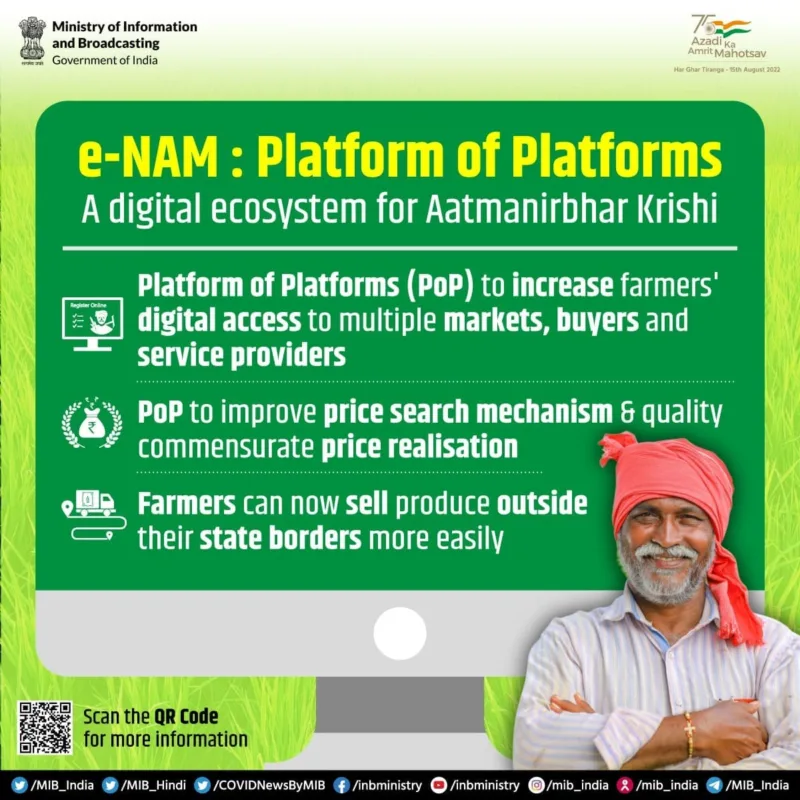
eNAM Portal in News | What’s New?
- Raw Biomass (Agri Residue) is now available as a tradable commodity on the e-NAM portal.
- All traders can now directly bid and procure Potatoes from e-NAM Mandis of Uttar Pradesh, without the requirement of a unified license and fees.
- In addition, Potatoes (Tomato, Bottle Gourd, Bitter Gourd, Mango, Green Chillies, Carrot, and Lady’s Finger) can also be traded from UP to promote Inter-state trade.
- Outside UP / other state traders can be given access in UP to participate in bids & procure these given commodities on their existing mandi license.
- 6 New Commodities were added on e-NAM. Now there are a total of 209 Commodities on eNam.
- New added commodities are under food Grains/Cereals and they are Little Millet, Kodo Millet, Barnyard Millet, Browntop Millet, Proso Millet, Amaranth Seed.
- Tamil Nadu Dept of Agriculture Marketing & Agri-Business, has amended the TN-APMC Act, wherein now all traders of e-NAM States/UT having Unified licenses, can trade at TN e-NAM mandis for Copra, Groundnut, Turmeric, Cotton, Maize, Paddy, Bajra and Moth.
- The e-NAM platform and mobile application were reinforced by introducing the FPO (Farmer Producer Organisation) trading module. This enables FPOs to trade their produce directly from their collection centers without the need to bring it to APMC.
- A warehouse-based trading module was launched in e-NAM, streamlining trade from warehouses using electronic Negotiable Warehouse Receipts (e-NWR).
- On July 14, 2022, the Platform of Platforms (POP) was introduced under the National Agriculture Market (e-NAM). This initiative allows farmers to sell their produce beyond state borders, expanding their digital access to multiple markets, buyers, and service providers. The POP enhances transparency in business transactions and encompasses 41 service providers offering various value chain services such as trading, quality checks, warehousing, fintech, market information, and transportation.
- AI-based assaying equipment has been integrated with the e-NAM platform.
Do you know :
Farmers can avail of the facility of partial payment in cash(as per the limits set by the respective states) and remain in their bank account for e-NAM trade. This is towards strengthening the vision towards “Ease of Doing Business”
Key features of eNAM include:
- National e-market Platform: Facilitating transparent sale transactions and price discovery for agricultural products.
- Liberal Licensing: Traders/buyers and commission agents are licensed by state authorities without the pre-condition of physical presence or possession of a shop in the market.
- Single License Valid Across Markets: A single trader license is applicable across all markets within the state.
- Harmonization of Quality Standards: Establishing common quality standards, testing, and tradable parameters for agricultural products in every market.
- Single Point Levy of Market Fees: Market fees are levied on the first wholesale purchase from the farmer.
- Provision of Soil Testing Laboratories: Soil testing laboratories are made available in or near selected mandis (markets).
- eNAM Mobile App: Accessible on Android, the mobile app enables farmers and traders to bid and complete transactions in eight languages.
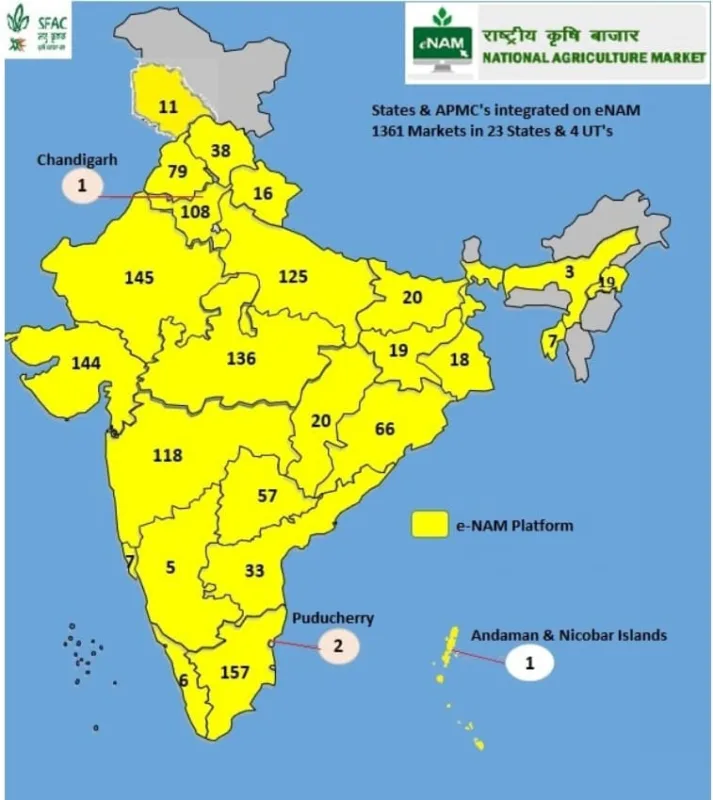
Components of the Scheme
- Selection of State/UT APMCs/RMCs involves mandatory reforms in their Acts and approval of Detailed Project Reports (DPR) by the Project Appraisal Committee (PAC), as per scheme guidelines.
- Provision of e-NAM software to States/UTs at no cost.
- Financial assistance to States/UTs for selected APMCs/RMCs, up to Rs.30.00 lakhs per market, for hardware, internet connections, assaying equipment, and infrastructure to integrate with e-NAM.
- Technical Assistance is provided by SFAC through Strategic Partner NFCL, offering one Mandi Analyst at each market for a year to support stakeholders in implementation.
- Private markets, if recommended by the competent authority, may gain e-NAM portal access, provided they arrange for Mandi Analyst, hardware, assaying facilities, and support services at their own cost.
- Capacity building through orientation for APMC/RMC staff and farmer awareness programs conducted with support from the strategic partner.
eNam Monitoring
Monitoring of the integration of existing mandis into the e-NAM portal involves a combination of periodic desk reviews, field visits, and a web-based mechanism to track physical progress. The Project Appraisal Committee (PAC) oversees the overall progress of scheme interventions at both state and national levels.
The monitoring and evaluation process will employ a coordinated approach, engaging various agencies:
- At the national level, the lead implementing agency (SFAC) collaborates with DMI/NIC, supported by the Strategic Partner (NFCL).
- At the state level, the respective department works with supporting agencies (SAMB/DAM/NFCL).
Stakeholders of the Scheme
The scheme involves various stakeholders, including:
- Beneficiaries: Farmers, APMCs/RMCs (mandis), Traders, Buyers, Processors, and Exporters.
- Support and Implementation: APMCs/RMCs (mandis), with the lead implementing agency being SFAC. NFCL DMI/NIC/SAMB/DAM serves as a strategic partner.
- Introduction and Management: DAC & FW, State Government Department, and District Administration are responsible for the initiation and oversight of the scheme
What is the Agricultural Produce Market Committee (APMC)?
An Agricultural Produce Market Committee (APMC) is a marketing board established by the state governments of India to protect farmers from potential exploitation by large retailers and to prevent retail prices from soaring unreasonably. This committee operates under the regulations outlined in the APLM Act. As of now, 1000 markets from 18 states and 3 Union Territories are connected to the e-NAM network.
To integrate their APMCs/mandis with e-NAM, states (specifically, State Agriculture Marketing Boards) need to implement the following reforms in their APMC Act:
- Introduce a unified trading license that is valid across the entire state.
- Implement a single-point levy of market fees throughout the state.
- Incorporate provisions for e-auction/e-trading as a means of price discovery.
How can one join e-Nam?
To participate in e-NAM, a farmer must engage with the nearest APMC/Mandi rather than directly accessing the eNAM portal. The farmer is required to visit the APMC for the sampling and auctioning of their produce. Following a meticulous examination, bidding, and electronic weighing of the sample, the payment will be disbursed to the farmer through methods such as Challan, Cheque, Internet Banking, RTGS, NEFT, and BHIM. For a more comprehensive understanding, one can refer to the e-NAM process flow.
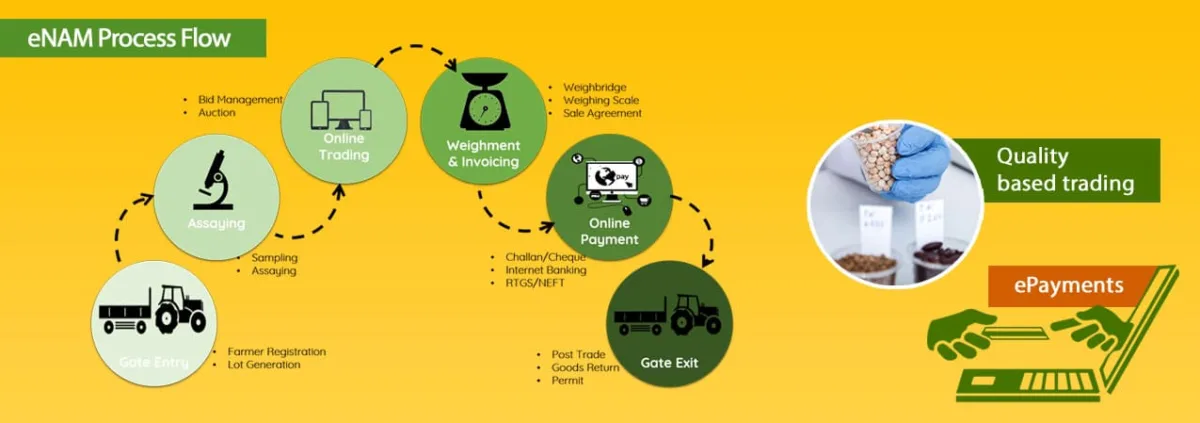
eNam Portal Online Registration (Online)
- Visit the official website of the National Agriculture Market or the eNam official website registration link to apply as a farmer.
- On the Registration Page, select “Registration Type” as “Farmer” and choose the preferred “APMC.”
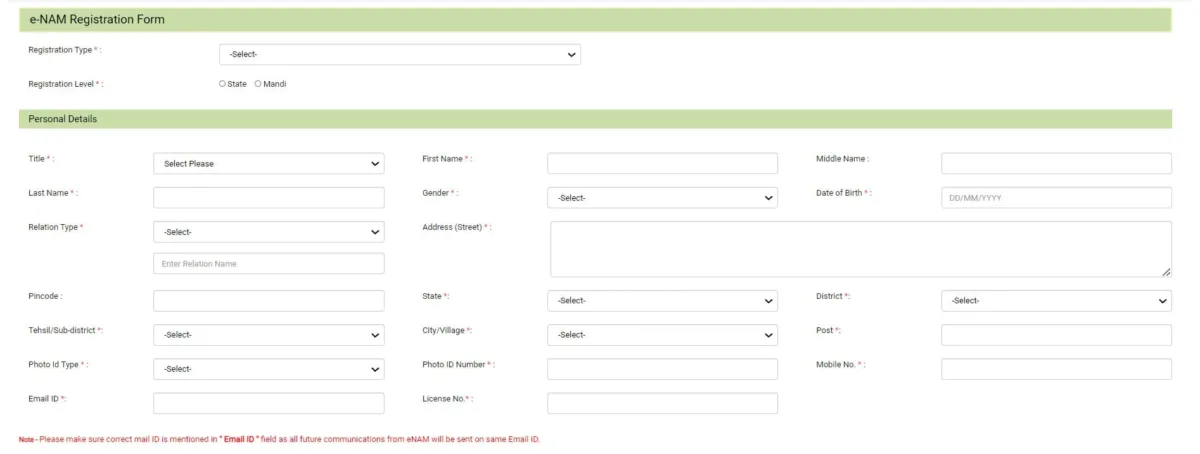
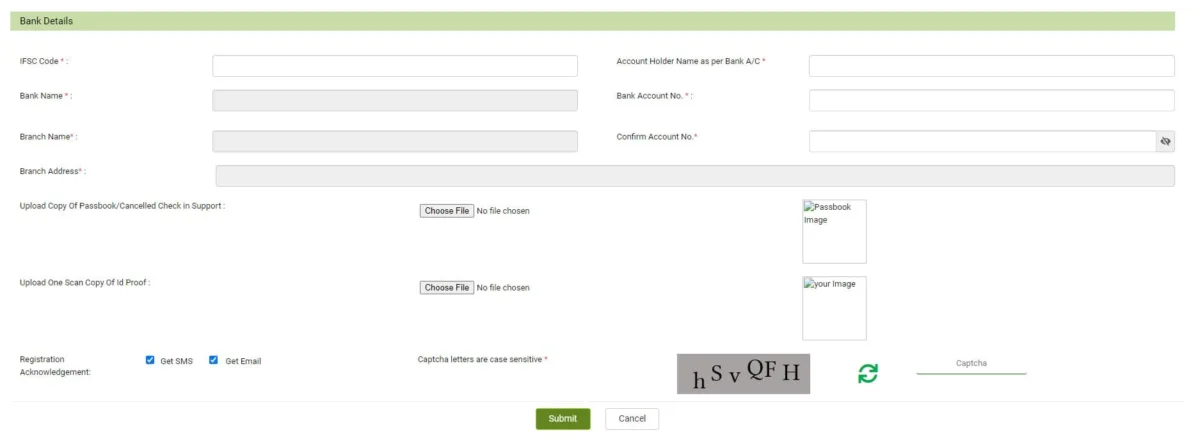
- Enter the correct Email ID, as the Login ID and Password will be sent to this email upon successful registration.
- After successful registration, a Temporary Login ID and password will be sent to the provided email.
- Log in to the Dashboard using the received credentials.
- On the Dashboard, find a flashing message instructing you to “Click here to register with APMC.”
- Click on the flashing link to be redirected to the Registration Page for filling/updating details.
- The application will be sent for approval to the selected APMC after completing the KYC process.
- After a successful login to the Dashboard, all APMC address details will be visible.
- Upon submission, the user will receive an email confirming the application’s status (Submitted/In progress/Approved/Rejected).
- Once approved by the APMC, the user will receive the eNAM Farmer Permanent Login ID and Password via the registered email.
- Alternatively, users can contact their respective Mandi/APMC for assistance.
eNam Scheme Result
- A uniform trading license is applicable across all markets within a state.
- Centralized market fee collection.
- Transparent price discovery through electronic auctions.
- Simplified procedures for acquiring trading licenses.
- Elimination of fragmented markets.
- Smooth transfer of agricultural commodities.
- Enhanced supply-chain efficiency leading to reduced wastage.
- Improved revenue share for farmers.
- Emphasis on wholesale-based sales.
- Informed training based on quality standards.
Achievements of the eNam Scheme
- Over 1.75 crore farmers and 2.43 lakh traders are registered on the e-NAM platform as of March 31, 2023.
- The e-NAM platform has onboarded 2,575 Farmer Producer Organizations (FPOs).
- A traded value of ₹2.50 lakh crore has been recorded on the e-NAM platform.
- As of March 16, 2023, 1361 mandis from 23 states and 4 Union Territories have been integrated with the e-NAM platform.
- The Electronic National Agriculture Market (e-NAM) initiative of the Ministry of Agriculture won the Platinum Award (1st) in the Digital Empowerment of Citizens category at the Digital India Award 2022.
eNam Commodities List
There are currently 209 committees under the eNam Portal. You can trade any of the commodities listed under the portal. For a complete list of commodities under eNam, please see below. This list is giving category-wise
| Commodity Category | No. of Commodities |
| FOOD GRAINS/ CEREALS | 33 |
| OILSEEDS | 14 |
| FRUITS | 43 |
| VEGETABLES | 57 |
| SPICES | 16 |
| MISC | 46 |
| Total commodities | 209 |
Complete List of Commodities ( As of November 2023)
| FOOD GRAINS/ CEREALS |
| 1. Amaranth Seed |
| 2. Arhar |
| 3. Arhar Dal Split |
| 4. Bajra |
| 5. Barley |
| 6. Barnyard Millet |
| 7. Basmati rice |
| 8. Browntop Millet |
| 9. Buck Wheat |
| 10. Chakhao Or Black Rice |
| 11. Chana Dal Split |
| 12. Chana whole |
| 13. Foxtail Millet |
| 14. Horse Gram |
| 15. Jowar |
| 16. Kabuli Chana Whole |
| 17. Kodo Millet |
| 18. Little Millet |
| 19. Lobia |
| 20. Maize |
| 21. Masoor whole |
| 22. Moong Dal Split |
| 23. Moong whole |
| 24. Moth |
| 25. Oats Raw |
| 26. Paddy |
| 27. Proso Millet |
| 28. Ragi |
| 29. Rajma |
| 30. Urad Dal Split |
| 31. Urad whole |
| 32. Wheat |
| 33. White Peas |
| OILSEEDS |
| 1. Castor seed |
| 2. Cotton Seed |
| 3. Kusum seed |
| 4. Linseed |
| 5. Mustard seed |
| 6. Neem Seeds |
| 7. Niger Seed |
| 8. Peanut kernel |
| 9. Pongam seeds |
| 10. Rapeseed |
| 11. Sal Seed |
| 12. Sesame seed |
| 13. Soyabean |
| 14. Sunflower seed |
| FRUITS |
| 1. Amla |
| 2. Apple |
| 3. Apricot |
| 4. Avocado |
| 5. Baji Banana |
| 6. Banana |
| 7. Ber |
| 8. Bilimbi |
| 9. Breadfruit |
| 10. Cherry Red / Black |
| 11. Custard apple |
| 12. Garcinia |
| 13. Grapefruit |
| 14. Grapes |
| 15. Guava |
| 16. Jackfruit |
| 17. Jamun |
| 18. Kinnow |
| 19. Lady Finger Banana |
| 20. Lemon |
| 21. Litchi |
| 22. Mango |
| 23. Mangosteen |
| 24. Mootty Fruit |
| 25. Muskmelon |
| 26. Mysore Banana |
| 27. Orange |
| 28. Papaya |
| 29. Papaya Raw |
| 30. Passion Fruit |
| 31. Peach |
| 32. Pear |
| 33. Pineapple |
| 34. Plum |
| 35. Pomegranate |
| 36. Rambutan |
| 37. Raw Mango |
| 38. Red Banana |
| 39. Sapota |
| 40. Soursop |
| 41. Strawberries |
| 42. Sweet orange |
| 43. Watermelon |
| VEGETABLES |
| 1. Aloe Vera |
| 2. Arrowroot |
| 3. Banana Raw |
| 4. Beetroot |
| 5. Bhindi/Okra |
| 6. Bitter gourd |
| 7. Bottle gourd |
| 8. Brinjal |
| 9. Broccoli/Calabrese |
| 10. Button Mushroom |
| 11. Cabbage |
| 12. Capsicum |
| 13. Carrots |
| 14. Cauliflower |
| 15. Cluster beans |
| 16. Colocasia vegetable |
| 17. Coriander leaves |
| 18. Cucumber |
| 19. Curry Leaves |
| 20. Drumstick |
| 21. Fenugreek Leaves |
| 22. Garlic |
| 23. Gherkin |
| 24. Ginger |
| 25. Green Amaranthus |
| 26. Green chillies |
| 27. Ivy gourd |
| 28. Jimikand (Suran) |
| 29. Lesser yam |
| 30. Lobia Pods |
| 31. Mint Leaves |
| 32. Mustard leaf |
| 33. Onion |
| 34. Oyster Mushroom |
| 35. Pea |
| 36. Pointed gourd |
| 37. Potato |
| 38. Pumpkin |
| 39. Raw Turmeric |
| 40. Red Amaranthus |
| 41. Reddish |
| 42. Ribbed celery |
| 43. Ridge Gourd |
| 44. Round chili |
| 45. Safed Petha |
| 46. Sem |
| 47. Snake Guard |
| 48. Spinach |
| 49. Sponge Gourd |
| 50. Spring Onion |
| 51. Sugar Snap Peas |
| 52. Sweet Corn |
| 53. Sweet potato |
| 54. Tapioca |
| 55. Tinda |
| 56. Tomato |
| 57. Winged bean |
| SPICES |
| 1. Ajwain |
| 2. Black Pepper Whole |
| 3. Cardamoms Whole |
| 4. Cloves Whole |
| 5. Coriander whole |
| 6. Cumin |
| 7. Dried Raw Mango Slices |
| 8. Dry Ginger |
| 9. Fennel seed |
| 10. Fenugreek seed |
| 11. Large cardamom |
| 12. Mace Whole |
| 13. Poppy Seed |
| 14. Red chili |
| 15. Tejpata |
| 16. Turmeric |
| MISC |
| 1. Anthurium |
| 2. Areca nut (betel nut) |
| 3. Bamboo |
| 4. Banana Stem |
| 5. Betel leaves |
| 6. Carnation |
| 7. Chhappan Kaddu |
| 8. Chironji |
| 9. Chrysanthemum |
| 10. Coconut |
| 11. Coconut with Husk |
| 12. Cotton |
| 13. Gerbera |
| 14. Ginger Seed |
| 15. Gladiolus |
| 16. Green Henna Leaf |
| 17. Groundnut with pods |
| 18. Guar seed |
| 19. Hilsa |
| 20. Isabgol |
| 21. JackFruit Seed |
| 22. Jaggery |
| 23. Jute Seeds |
| 24. Lily |
| 25. Mahua flower |
| 26. Mahua Seed |
| 27. Marigold |
| 28. Nutmeg Whole |
| 29. Persimmon |
| 30. Raisins |
| 31. Raw Arrowroot Powder |
| 32. Raw Cashew nut |
| 33. Raw Coffee Beans |
| 34. Raw Honey |
| 35. Raw Jute |
| 36. Rittha |
| 37. Rose Cut Flower |
| 38. Safed Musli |
| 39. Saffron |
| 40. Silk Cocoon |
| 41. Spray Chrysanthemum |
| 42. Tamarind |
| 43. Tender coconut |
| 44. Tuberose |
| 45. Tulip |
| 46. Walnuts In Shell |
eNam FAQs
What sets e-NAM apart from the existing mandi system?
e-NAM differs from the traditional mandi system as it doesn’t establish a separate marketing structure but functions as a national network connecting physical mandis online. It aims to utilize existing mandi infrastructure by providing an online trading portal, facilitating participation from buyers located beyond the Mandi/State boundaries.
What are the conditions for states to join e-NAM?
States interested in integrating their mandis with e-NAM must implement three key reforms in their APMC Act:
a) Adoption of a unified trading license valid across the entire state.
b) Implementation of a single-point levy of market fees throughout the state.
c) Inclusion of provisions for e-auction/e-trading as a mode of price discovery.
Who is the leading implementing agency for operating the e-NAM platform?
The Ministry of Agriculture & Farmers’ Welfare, Government of India, has designated the Small Farmers’ Agribusiness Consortium (SFAC) as the Lead Implementing Agency for e-NAM. SFAC, with the assistance of a Strategic Partner (currently NFCL), will operate and maintain the e-NAM platform.
How many commodities are under the eNam platform?
There are 209 commodities available for trade under the eNam portal. This data is from November 2023. You can download the complete list of commodities to check whether your preferred commodity is on the list or not.
What is eNam? How it is useful for farmers?
The National Agriculture Market, commonly referred to as eNAM, stands as a prominent initiative by the Government of India aimed at establishing a consolidated national marketplace for agricultural commodities. Farmers can sell their produce through this portal without having any middleman which will result in a higher profit margin for the farmers.
| OTHER AGRICULTURAL SCHEME FOR FARMERS |
| PM FASAL BIMA YOJANA |
| PM KISAN SAMMAN NIDHI YOJANA |
